Prof. Kristiansen (University of Gothenburg) explains how #Yamnaya pastoralists committed a 'male genocide' as they invaded and settled Europe by way of #Männerbund:
“How was that possible: based on a recent global study of captives in pre-state societies by Cathy Cameron, she demonstrates that in all known societies raiding for women for labour and reproduction was common, and also common was to kill the males, to prevent revenge, or at least reduce their capacity for immediate revenge. We find more and more archaeological examples of massacres, sometimes only of young males from the 3rd millennium and onwards. Taken together it suggests a prevailingly violent relationship between remaining Neolithic groups and the new migrants, which does not preclude the Neolithic women could have themselves looked up these more successful groups from time to time for marriage. But the fact still remains that Neolithic males did get extinct, therefore the term male genocide.”
“How was that possible: based on a recent global study of captives in pre-state societies by Cathy Cameron, she demonstrates that in all known societies raiding for women for labour and reproduction was common, and also common was to kill the males, to prevent revenge, or at least reduce their capacity for immediate revenge. We find more and more archaeological examples of massacres, sometimes only of young males from the 3rd millennium and onwards. Taken together it suggests a prevailingly violent relationship between remaining Neolithic groups and the new migrants, which does not preclude the Neolithic women could have themselves looked up these more successful groups from time to time for marriage. But the fact still remains that Neolithic males did get extinct, therefore the term male genocide.”
Some of the oldest archaeological sites at which wheels/wagons were found are #CordedWare & #Yamnaya (Indo-European).
Image: a) two solid wooden wheels from Bal'ki kurgan, #Ukraine, radiocarbon dated to 3330 - 2900 BCE; b) Catacomb-culture (Ukraine) tripartite wheel with dowels, 2600 - 2200 BCE; c) preserved axle and reconstructed wagon from fragments found in bog deposits in northwestern #Germany & #Denmark (Corded Ware) dated to 3000 - 2800 BCE.
Image: a) two solid wooden wheels from Bal'ki kurgan, #Ukraine, radiocarbon dated to 3330 - 2900 BCE; b) Catacomb-culture (Ukraine) tripartite wheel with dowels, 2600 - 2200 BCE; c) preserved axle and reconstructed wagon from fragments found in bog deposits in northwestern #Germany & #Denmark (Corded Ware) dated to 3000 - 2800 BCE.
A new genetic study shows the homogeneity of #Lithuania's population, the preservation of an extremely high #Yamnaya component and its relative isolation, accounting for archaic linguistic preservation...
"Our results show that Lithuanians are a homogenous population, genetically differentiated from neighbouring populations but within the general expected European context. Moreover, we not only confirm that Lithuanians preserve one of the highest proportions of western, Scandinavian and eastern hunter-gather ancestry components found in European populations but also that of a Steppe Early to Middle Bronze Age pastoralists, which together configure the genetic distinctiveness of the Lithuanian population."
(Source)
Image by Magdalena Stankūnas.
"Our results show that Lithuanians are a homogenous population, genetically differentiated from neighbouring populations but within the general expected European context. Moreover, we not only confirm that Lithuanians preserve one of the highest proportions of western, Scandinavian and eastern hunter-gather ancestry components found in European populations but also that of a Steppe Early to Middle Bronze Age pastoralists, which together configure the genetic distinctiveness of the Lithuanian population."
(Source)
Image by Magdalena Stankūnas.
Burial mounds, or Kurgans, are an innovation of the Indo-Europeans. #Yamnaya archaeological sites are littered with this distinctive custom, as are historical sites across northern Europe. The spread of these sites across #AngloSaxon England demonstrates some sort of cultural/religious continuum between the Steppe peoples and their Germanic progeny.
